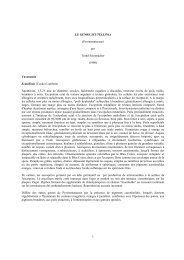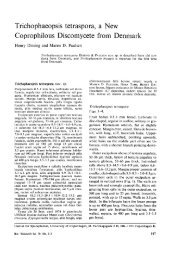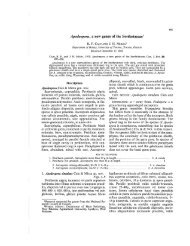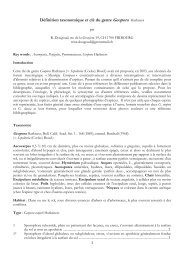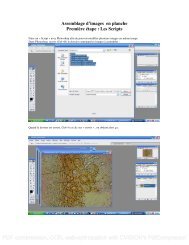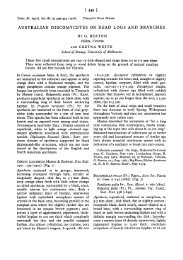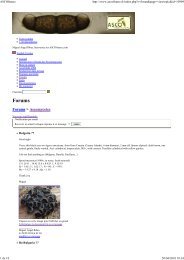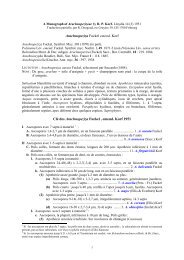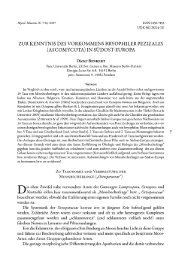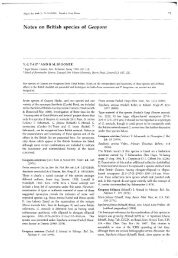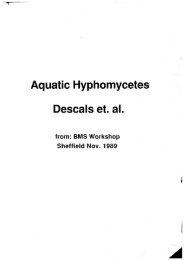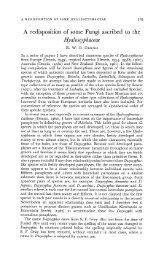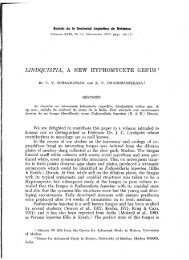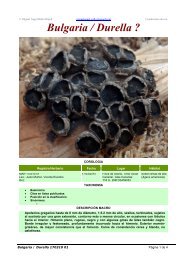Stray Studies in the Coronophorales (Pyrenomycetes) 4-8 - ASCOfrance
Stray Studies in the Coronophorales (Pyrenomycetes) 4-8 - ASCOfrance
Stray Studies in the Coronophorales (Pyrenomycetes) 4-8 - ASCOfrance
Create successful ePaper yourself
Turn your PDF publications into a flip-book with our unique Google optimized e-Paper software.
320 J. A. NannfeldtSphaeria (Byssisedae) hystricula Berk. & Br., J. L<strong>in</strong>n. Soc. 14:125 (1873). —Rosell<strong>in</strong>iahystricula Sacc., Syll. fung. 1:274 (1882). —Chaetosphaeria hystricula Cke, Grevillea 15(=n.76): 124 (1887). — Fracchiaea hystricula Petch, Ann. R. Bot. Gard. Peradeniya 5(4): 290 (1912;non sensu Petch, q.e. Ac. pulchella). — Typus: Ceylon, Thwaites 171 p.p. = 1074 1 (isotypus:UPS!).["Trichosphaeria acanthostroma (Mont.) Sacc." sensu Speg., Anal. Soc. Cie. Argent<strong>in</strong>a26:28 (1888). — Cp. Nannfeldt 1975:58.]Meliolopsis usambarensis Rehm <strong>in</strong> P. Henn., Deutsch Ost-Afrika 5C:31 (1895). —Euacan<strong>the</strong> usambarensis Theiss., Ann. Mycol. 15(3-4):272 (1917). — Scortech<strong>in</strong>iausambarensis Arx & Müll., Beitr. Krypt.-fl. Schweiz 11(1): 381 (1954). — Tympanopsisusambarensis Müll. & Arx, Phytopath. Zeitschr. 24(4):365 (1955). — Typus: Burundi, Hoist(S!).Acanthonitschkea macrobarbata Fitzp., Mycologia 15(2):63 (1925). — Typus: Tr<strong>in</strong>idad,Thaxter (FH!).? Fitzpatrickia Massae Cif., Mycologia 20(1):30 (1928). — Scortech<strong>in</strong>ia Massae Arx &Müll., Beitr. Krypt.-fl. Schweiz 11(1): 381 (1954). — Tympanopsis Massae Müll. & Arx,Phytopath. Zeitschr. 24(4): 366 (1955). — Typus: loc., temp, et matr. ignot., leg. C. Massa(School of Viticulture and Enology, Alba, Italy; n.v.). — Cp. Nannfeldt 1975:60.Ascocarps 0.25-0.5 mm with bristles 200-300 /tm long. Asci 8-sporous. Sporesovoid or ellipsoid to subfusiform, <strong>in</strong>equilateral, almost straight, 5-8x2-3 ¿¿m,hyal<strong>in</strong>e (eventually with brownish wall?), with 2 drops, as a rule confluent to oneeccentrically placed.DISTRIBUTION: Known from <strong>the</strong> Americas (USA: South Carol<strong>in</strong>a fide Berkeley1868:387, Cuba, Tr<strong>in</strong>idad, Brazil, Paraguay), tropical Africa (Burundi), and tropicalAsia (Ceylon).(3) Acanthonitschkea pulchella (Sacc.) Nannf. nov. comb.Neotrotteria pulchella Sacc., Bull. Orto Bot. R. Univ. Napoli 6:45 (1918). — Typus:S<strong>in</strong>gapore, Baker 5277 (n.v.; comp. Petrak 1962:353).["Fracchiaea hystricula (Berk. & Br.) Petch" sensu Petch, Ann. R. Bot. Gard. Peradeniya5(4):229 (1912); non s. orig., q.e. Ac.foveolata.]Petelotia tonk<strong>in</strong>ensis Pat., Bull. Soc. Mycol. France 40(1):35 (1921). — Typus: NorthVietnam, Petelot 570 (holotypus: FH!).Ascocarps 0.3-0.5 mm with bristles 100-250 fim long. Asci ca. 32-sporous. Sporessuballantoid, 6-12x 1.5-2(-2.5) /u.m, hyal<strong>in</strong>e, with 2(-3) droplets.DISTRIBUTION: Tropical Africa (Ghana, IMI!; Hughes 1953: 18 as Fr.hystr.)and tropical Asia (Ceylon, North Vietnam, Malaya). A sample (IMI 104 902) fromNorth Borneo may also belong here, but its stage is too advanced for certa<strong>in</strong>determ<strong>in</strong>ation.—The matrix is <strong>in</strong> most cases Heveabrasiliensis.1 Expressions such as "nos. 1074, 171 <strong>in</strong> part" frequently used by Berkeley & Broome <strong>in</strong> connection withThwaites' Ceylon fungi do not <strong>in</strong>dicate two different collections but mean that part of a mixed collection (<strong>in</strong>this case 171) was given a number (1074) of its own (Petch 1912:266).Svensk Bot. Tidskr. 69 (1975)



